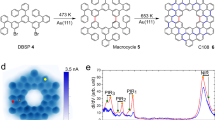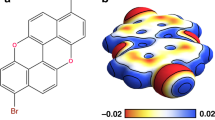Abstract
GRAPHITE is a popular choice as a substrate for the study of absorption of molecules on surfaces because of its relatively simple interaction with adsorbates and the ease of preparing a clean and homogeneous surface. Here we use scanning tunnelling microscopy (STM) to probe the graphite/liquid-crystal interface and we examine what we believe to be the first monolayer of the liquid with atomic resolution. We resolve the different functional groups of the molecules and determine their orientation and packing arrangement. By decreasing the tunnel-gap resistance we examine the underlying graphite substrate and deduce the registry of the adsorbed molecules with the graphite. We thus propose a microscopic picture of the adsorption and formation of the interfacial structure. We find that aromatically bonded carbon atoms are visible in the STM images whereas tetrahedrally- and triple-bonded carbon are invisible. Hydrogen and nitrogen atoms can also be seen, although with less apparent height than the aromatic carbon. Molecular orbital calculations predict electron densities in good agreement with the observed STM contrast.
This is a preview of subscription content, access via your institution
Access options
Subscribe to this journal
Receive 51 print issues and online access
$199.00 per year
only $3.90 per issue
Buy this article
- Purchase on Springer Link
- Instant access to full article PDF
Prices may be subject to local taxes which are calculated during checkout
Similar content being viewed by others
References
Foster, J. S. & Frommer, J. E. Nature 333, 542–545 (1988).
Smith, D. P. E., Hörber, H., Gerber, Ch. & Binnig, G. Science 245, 43–45 (1989).
Everett, D. H. & Findenegg, G. H. Nature 223, 52–53 (1969).
Foster, J. S., Frommer, J. E. & Spong, J. K. Proc. SPIE 1080, 200–208 (1989).
McGonigal, G. C., Bernhardt, R. H. & Thomson, D. J. Appl. Phys. Lett. (in the press).
Berker, A. N., Ostlund, S. & Putnam, F. A. Phys. Rev. B17, 3650–3665 (1978).
Groscek, A. J. Proc. R. Soc. Lond. A 314, 473–498 (1970).
Hansma, P. K. & Tersoff, J. J. appl. Phys. 61, R1–R23 (1987).
Lippel, P. H., Wilson, R. J., Miller, M. D., Wöll, Ch. & Chiang, S. Phys. Rev. Lett. 62, 171–174 (1989).
Spong, J. K. et al. Nature 338, 137–139 (1989).
Hansma, P. K., Elings, V. B., Marti, O. & Bracker, C. E. Science 242, 209–242 (1988).
Frisch, M. J. et al. Gaussian 86 (Carnegie-Mellon Quantum Chemistry Publishing Unit, Pittsburgh, 1984).
Author information
Authors and Affiliations
Rights and permissions
About this article
Cite this article
Smith, D., Hörber, J., Binnig, G. et al. Structure, registry and imaging mechanism of alkylcyanobiphenyl molecules by tunnelling microscopy. Nature 344, 641–644 (1990). https://doi.org/10.1038/344641a0
Received:
Accepted:
Issue Date:
DOI: https://doi.org/10.1038/344641a0
Comments
By submitting a comment you agree to abide by our Terms and Community Guidelines. If you find something abusive or that does not comply with our terms or guidelines please flag it as inappropriate.



